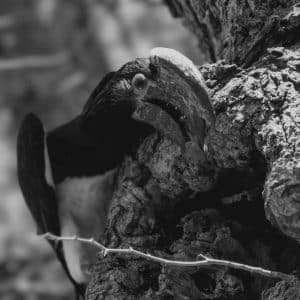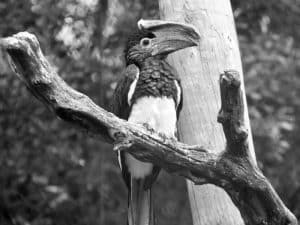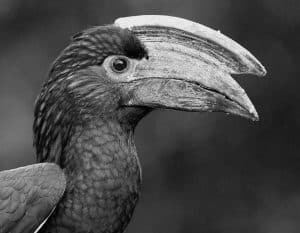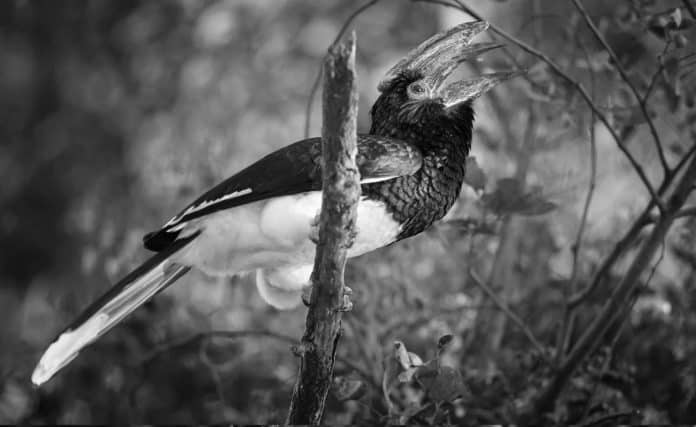Introduction to the Trumpeter Hornbill
Welcome to the enchanting world of the trumpeter hornbill, a majestic bird whose presence graces the woodlands of Tanzania. The trumpeter hornbill, scientifically known as Bycanistes bucinator, is a striking species known for its vibrant plumage and impressive vocalizations. Found in the lush forests and woodlands of Tanzania, these birds have captured the fascination of bird enthusiasts and nature lovers alike. In this comprehensive guide, we will explore the habitat, behavior, cultural significance, and conservation efforts related to the trumpeter hornbill in Tanzania. Get ready to embark on a journey into the heart of Tanzanian woodlands and discover the captivating world of the trumpeter hornbill.
Habitat and Distribution of the Trumpeter Hornbill in Tanzania

The trumpeter hornbill is native to the woodlands and forests of Tanzania, where it thrives in the rich and diverse ecosystems of the region. These magnificent birds are known to inhabit both lowland and montane forests, often favoring areas with dense vegetation and ample fruit-bearing trees. In Tanzania, their distribution spans across various regions, including the Eastern Arc Mountains, the Southern Highlands, and the coastal forests. The diverse landscape of Tanzania provides the perfect environment for the trumpeter hornbill to flourish, ensuring their presence in both protected reserves and natural habitats.
The unique distribution of the trumpeter hornbill within Tanzania showcases the adaptability of this species to a range of forested environments. From the verdant canopies of the Eastern Arc Mountains to the coastal woodlands along the shores of the Indian Ocean, these birds have carved out their niche in the country’s natural tapestry. Understanding the specific habitats and distribution patterns of the trumpeter hornbill is essential for appreciating their role in the Tanzanian ecosystem and the conservation efforts aimed at preserving their natural habitats.
Physical Characteristics of the Trumpeter Hornbill
Distinguished by their striking appearance, the trumpeter hornbills are a sight to behold in the Tanzanian woodlands. These birds are adorned with vibrant plumage, featuring a combination of black, white, and splashes of vivid color that adorn their beaks and facial skin. Their large, curved bills are not only a visual spectacle but also serve practical purposes, allowing them to forage for fruits and small prey within the dense foliage. The impressive size of the trumpeter hornbill, with adults reaching lengths of over 60 centimeters, further adds to their commanding presence in the forest canopy.
One of the most iconic features of the trumpeter hornbill is its resonant call, which reverberates through the woodlands of Tanzania. This distinctive vocalization, resembling the sound of a trumpet, has earned the bird its evocative name and serves as a defining characteristic of its presence in the wild. The physical attributes of the trumpeter hornbill, from its vibrant plumage to its formidable bill and resonant call, contribute to its allure as an emblematic species within the Tanzanian woodlands.
Behavior and Social Structure of the Trumpeter Hornbill
The behavior of the trumpeter hornbill reflects a complex and social nature, as these birds engage in intricate interactions within their forest habitats. They are often observed in small groups or pairs, forming strong social bonds that are vital for their survival and reproduction. The trumpeter hornbill’s foraging behavior involves searching for a variety of fruits, insects, and small animals within the forest canopy, utilizing their specialized bills to access hidden delicacies.
During the breeding season, the trumpeter hornbill exhibits fascinating nesting behavior, with females selecting tree cavities as nesting sites and sealing themselves inside with a mixture of mud, droppings, and fruit pulp. This remarkable adaptation serves to protect the female and her offspring from potential predators, highlighting the intricate nesting behavior of the species. The cooperative nature of trumpeter hornbill pairs in raising their young showcases the strong familial bonds that define their social structure, adding depth to their captivating behavior in the wild.
Importance of the Trumpeter Hornbill in Tanzanian Ecosystem
The presence of the trumpeter hornbill holds significant ecological importance within the Tanzanian ecosystem, contributing to the dynamics of forest regeneration and seed dispersal. As frugivorous birds, trumpeter hornbills play a crucial role in the dispersal of seeds from various fruit-bearing trees, aiding in the propagation of plant species across the forest landscape. Their foraging behavior and dietary preferences influence the distribution and abundance of plant species, shaping the biodiversity of the woodlands they inhabit.
The interactions between the trumpeter hornbill and its surrounding environment create a delicate balance that fosters the health and resilience of Tanzanian forests. By consuming fruits and dispersing seeds across the landscape, these birds contribute to the regeneration of forest ecosystems, influencing the composition of plant communities and supporting the overall biodiversity of the region. Understanding the ecological significance of the trumpeter hornbill underscores the interconnectedness of species within the Tanzanian woodlands and the intricate role these birds play in shaping their natural environment.
Conservation Efforts for the Trumpeter Hornbill

Efforts to conserve the trumpeter hornbill and its natural habitats are essential for ensuring the continued presence of this iconic species in Tanzania. The conservation initiatives aimed at protecting the trumpeter hornbill encompass various strategies, including habitat preservation, community engagement, and research efforts focused on understanding the ecological needs of the species. Conservation organizations and governmental agencies work collaboratively to designate protected areas and implement sustainable practices that safeguard the forested habitats crucial for the survival of the trumpeter hornbill.
Community-based conservation programs play a pivotal role in raising awareness about the importance of the trumpeter hornbill and engaging local communities in efforts to protect their natural habitats. By involving local stakeholders in conservation activities and promoting sustainable land management practices, these initiatives contribute to the long-term preservation of the trumpeter hornbill’s presence in Tanzanian woodlands. Furthermore, research endeavors aimed at monitoring population trends, behavior patterns, and ecological interactions of the species provide valuable insights that inform targeted conservation strategies, ensuring the viability of the trumpeter hornbill in the wild.
Best Places for Birdwatching and Spotting Trumpeter Hornbills in Tanzania
For avid birdwatchers and nature enthusiasts, Tanzania offers a wealth of opportunities to observe the captivating presence of the trumpeter hornbill in its natural habitat. The diverse landscapes and rich biodiversity of the country provide an ideal setting for birdwatching, with several key locations known for their abundance of bird species, including the iconic trumpeter hornbill. When planning a birdwatching excursion in Tanzania, consider visiting renowned national parks such as the Udzungwa Mountains National Park, the Selous Game Reserve, and the Kilombero Valley, where the lush woodlands provide prime birdwatching opportunities.
The Udzungwa Mountains National Park, nestled within the Eastern Arc Mountains, is celebrated for its exceptional birdlife, offering visitors the chance to encounter the trumpeter hornbill amidst the verdant forests and cascading waterfalls. Similarly, the Selous Game Reserve, a UNESCO World Heritage Site, boasts diverse habitats that are home to a myriad of bird species, making it an ideal destination for spotting the trumpeter hornbill in its natural environment. The Kilombero Valley, with its mosaic of wetlands, woodlands, and floodplains, provides a rich tapestry of birdwatching opportunities, allowing enthusiasts to witness the vibrant plumage and distinctive calls of the trumpeter hornbill.
Capturing the Trumpeter Hornbill: Photography Tips and Techniques
Photographing the striking beauty of the trumpeter hornbill amidst the Tanzanian woodlands presents a thrilling opportunity for wildlife photographers and enthusiasts. To capture captivating images of these iconic birds, it is essential to employ effective photography techniques that showcase their vibrant plumage, unique behaviors, and natural habitat. When embarking on a photography expedition to document the trumpeter hornbill, consider utilizing telephoto lenses to capture intricate details from a distance while respecting the natural behavior of the birds.
Patience is key when photographing the trumpeter hornbill, as their presence in the forest canopy may require careful observation and an understanding of their behavioral patterns. Positioning oneself near fruiting trees or known foraging sites can increase the likelihood of encountering these birds in their natural habitat, providing opportunities to capture them in action. Additionally, paying attention to lighting conditions and the surrounding environment can elevate the visual impact of the photographs, creating stunning compositions that convey the essence of the trumpeter hornbill’s presence in Tanzanian woodlands.
The Role of the Trumpeter Hornbill in Tanzanian Folklore and Culture

Beyond its ecological significance, the trumpeter hornbill holds a revered place in Tanzanian folklore and cultural traditions, where it is often depicted as a symbol of strength, resilience, and natural beauty. In various indigenous narratives and oral traditions, the trumpeter hornbill is celebrated for its majestic presence and distinctive call, which are woven into the fabric of local folklore. Its vibrant plumage and commanding stature have inspired artistic representations and symbolic interpretations, reflecting the deep-rooted connection between the species and Tanzanian cultural heritage.
The trumpeter hornbill’s influence extends beyond folklore, as it is intricately intertwined with traditional rituals and customs in Tanzanian communities. The bird’s significance is reflected in ceremonial practices, where its imagery and symbolism are invoked to signify prosperity, protection, and spiritual significance. The cultural reverence for the trumpeter hornbill underscores the profound impact of this species on the cultural identity of Tanzania, highlighting the enduring legacy of its presence within the country’s rich tapestry of traditions and beliefs.
Conclusion: Preserving the Trumpeter Hornbill’s Presence in Tanzanian Woodlands
As we conclude our exploration of the trumpeter hornbill’s presence in Tanzanian woodlands, it is evident that these magnificent birds hold a unique position in the natural, cultural, and ecological landscape of the region. From their vital role in seed dispersal and forest regeneration to their symbolic significance in Tanzanian folklore and cultural traditions, the trumpeter hornbill embodies the interconnectedness of biodiversity and human heritage. The conservation of their natural habitats and the promotion of sustainable practices are essential for preserving the enduring presence of the trumpeter hornbill in Tanzanian woodlands for generations to come.
In the spirit of safeguarding the trumpeter hornbill’s legacy, it is imperative to support conservation initiatives, engage local communities, and raise awareness about the importance of protecting their habitats. By fostering a harmonious coexistence between humans and wildlife, we can ensure that the captivating call of the trumpeter hornbill continues to echo through the Tanzanian woodlands, enriching the natural tapestry of the region and inspiring future generations to cherish and preserve the irreplaceable biodiversity of Tanzania.

































